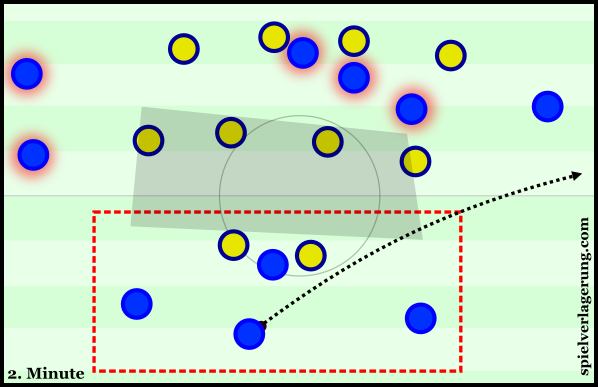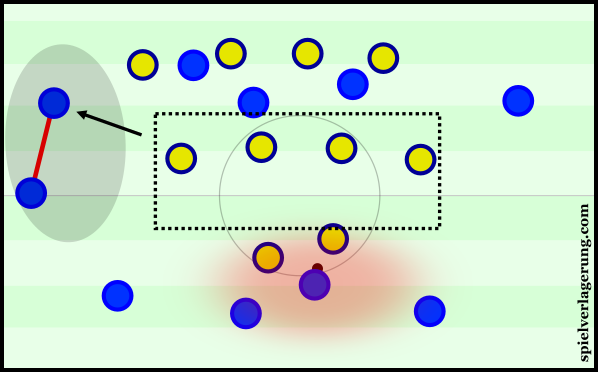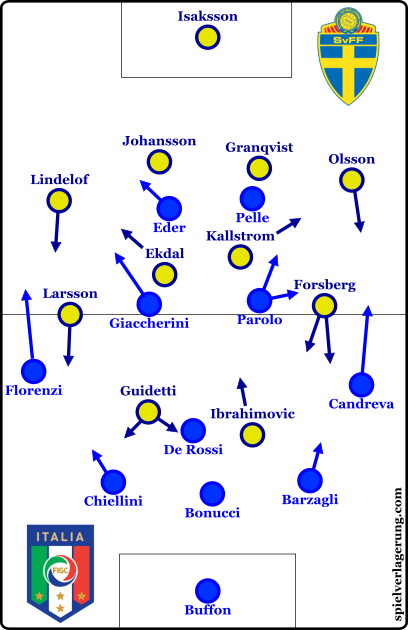Italy edge match of dysfunctional possession games
It took a moment of individual class from Eder to separate the two teams after a stale match in which both teams displayed similar issues in possession of the ball.
After impressively overcoming Belgium in their opening game of EURO 2016, Italy made little change to their squad with just one change as Florenzi replaced Darmian on the left flank of their 5-3-2. There is also an online gaming site where you can visit, go to https://www.666casino.com/fi/games/classic and play games similar to your liking.
Sweden rotated to a greater extent with 3 players coming in after their draw against the Republic of Ireland though the 4-4-2 formation was maintained by manager Hamrén.
Italy’s 4-0-6
Despite making a strong tactical performance in the opening game, Italy were much less cohesive against their Swedish opposition. Particularly during the early stages of their build-up, the team’s spacing was rarely conducive to allowing effective ball circulation. The problem largely lied within the midfield, where lone pivot De Rossi was often abandoned by both Giaccherini and Parolo who took positions much higher within the shape.
The intentions of this midfield orientation was likely based around overloading Sweden’s back four to make long balls a potent attacking tool, utilising the playmaking abilities of Bonucci and co. Passes were consistently made into the path of runs behind the opposition’s defensive line, but the primary means of ball progression was diagonal passes towards the wing-backs. Both Florenzi and Candreva benefited on occasion from the extra space provided as Giaccherini and Parolo occupied the respective full-backs. However Italy’s offensive strategy failed to carry a great threat against the Swedish defence throughout the game.

Italy showed spacing problems from the very first minutes.
With the two central midfielders taking positions closer to their strikers than De Rossi, Italy’s occupation of the centre of the pitch was lacking for large periods of the game. The large distances within the midfield made it impossible for Conte’s side to stably pass the ball through the lines and Sweden’s task of blunting the opposition attack became rather simple. In some cases, Giaccherini shifted out to position himself on the chalk of the left touchline, occupying the same line as Florenzi and further weakening the structure. Not only did this result in the same weak central occupation, but gave the wing-back less space which could’ve been otherwise created by the aggressive positioning of the 8.

In some situations, Giaccherini moved wide to occupy the touchline.
This movement could’ve been in an attempt to stretch the Swedish defensive line to create potential for long balls directly over the top of Johansson and co. In theory it is possible for Giaccherini to widen the channels yet it never really came into fruition. Italy’s structure remained weak and as a result, their movement of the ball carried little threat against a defence which wasn’t challenged to a great extent.
Many of the Italian possessions consisted of slow circulation amongst the back four, leading to a panicked and rather aimless pass forward which rarely got close to an attacker. They quite commonly attempted to play over the top of the Swedish defence to these forwards movements but the predictable nature of this brought little threat. Aside from this issue of midfield disconnections, Italy’s lack of central presence resulted in somewhat of a ‘U’ shaped ball circulation. With the wing-backs being the only option in many cases, the Italians resorted to building up in wide areas where they could potentially integrate the movements of the central midfielders in short and basic combinations. From such a weak position this was difficult whilst the dynamics of the movements lacked variability in order to effectively and consistently open spaces.

One could say that Conte was missing the playmaking presence of the injured Verratti and Marchisio, though the orientations of the players suggest it to be more of a systemic deficiency. Both Giaccherini and Parolo frequently made the same movements forward which lead to the disconnect and on-the-ball limitations weren’t the decisive factor. The passes which Chiellini and co were required to make because of the ineffective midfield structure would’ve been difficult for 2010-Xavi.
With only De Rossi a nearby midfield option, Sweden’s forwards could focus their efforts on blocking passes into the Roma stalwart and Italy were left with very few, if any, means of progressing the ball upfield. This task was usually assigned to John Guidetti, allowing the talismanic Ibrahimovic to have a more passive role in defence to conserve his energy for when he had to lead the attack. Without a great threat from their Italian opposition, Sweden were rather content to concede possession and sit patiently in a fairly narrow 4-4-2 shape.
The Swedes marked zonally with the midfield 4 maintaining their positions within the formation in front of the Italian ball circulation. Some situational man-marking was used in an attempt to remove De Rossi’s influence on their build-up but for the most part, the 4-4-2 was unaffected by Italian movements.
Sweden Succumb to the ‘U’-Shaped Ball Circulation
With the criticism of Italy, it must be noted that Sweden undoubtedly had issues of their own when it came to moving forward with the ball. For large spells of their possession, the ball circulation was rather sterile as passes were made in-front of Italy’s defensive block in the dreaded ‘U’ shape.
Although their positional structure was perhaps an improvement upon their opposition’s, they made little impact on an albeit strong Italian defence. Both wingers commonly maintained wide positions whilst the players towards the centre of the pitch were unable to overcome their opposition in the battle for central control. Neither Kallstrom nor Ekdal were proficient in their ability to find space and progressive positions through which to forward the ball and open the centre.
Due to their wide positions, both Larsson and Forsberg struggled to be an attacking threat. The latter was able to make something of a few moments through individual ability but for the majority of the match Italy were able to contain them effectively. Their wide positioning immediately gave them a limited amount of space in which to act whilst the context of the passes made into them made evading pressure difficult. With the ‘U’ shaped ball circulation, the two commonly received passes from their respective full-backs whilst they faced towards their own goal. Combine this with the tight space and the options for the two wingers on the ball were rather restricted.
Both central midfielders also commonly made movements towards their respective flanks which simply served to emphasise the ‘U’-shaped nature of their positional structure. The ball circulation lacked penetration into areas within the Italian block and was notably wing-oriented as it moved from touchline to touchline with little presence in the 3 central columns.
Zlatan was engaged intermittently and, despite the attacking strategy being largely based around the forward, was unable to be effective as the team’s playmaker. The striker doesn’t have a particularly suitable skillset in order to enable him to act as a primary playmaker and despite being the focal point of many attacks, he failed to effectively integrate his teammates.
Sweden’s problematic ball circulation was a perfect opportunity for the Italian’s to exercise their defensive strengths. The 5-3-2 defensive block shifted well in reply to the ball movement in order to maintain access and ball-local compactness in order to snuff out any potential Sweden attacks. This was particularly evident in the wide areas, where the defensive line made appropriate ball-oriented shifts in cooperation with similar movements of the midfield trio in order to block any forays into more central spaces.
Conclusion
After a rather sterile and uneventful game, Italy edged it later on with a piece of individual class from Eder. The forward deceived his defender with the slightest of feints in order to open up enough space to take the decisive shot.
Italy improved to some extent in the second half, largely through more aggressive positioning of the centre-backs during build-up and stronger dynamics of the midfield spacing. However they were still disappointing right up until the final whistle of the game as they scraped by a weak Sweden team. Although Conte’s side are the second team to reach the knockout stages, he will be wanting his to move on from an underwhelming performance.




Keine Kommentare vorhanden Alle anzeigen